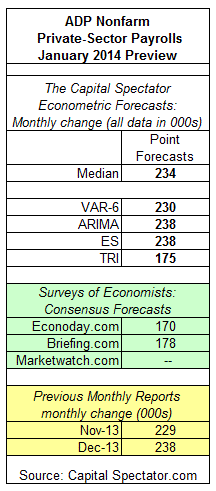Private nonfarm payrolls in the US are projected to increase by 234,000 (seasonally adjusted) in tomorrow’s January release of the ADP Employment Report, based on the The Capital Spectator’s median econometric point forecast. The projected gain is slightly below the previously reported increase of 238,000 for December. Meanwhile, The Capital Spectator’s median projection for January is substantially above a pair of consensus forecasts based on surveys of economists.
Here’s a closer look at the numbers, followed by brief definitions of the methodologies behind The Capital Spectator’s projections:
VAR-6: A vector autoregression model that analyzes six economic time series in context with the ADP private payroll employment. The six additional series: the ISM Manufacturing Index, industrial production, index of weekly hours worked, US stock market (S&P 500), spot oil prices, and the Treasury yield spread (10 year Note less 3-month T-bill). The forecasts are run in R with the “vars” package.
ARIMA: An autoregressive integrated moving average model that analyzes the historical record of the ADP private payroll employment data in R via the “forecast” package.
ES: An exponential smoothing model that analyzes the historical record of the ADP private payroll employment data in R via the “forecast” package.
TRI: A model that’s based on combining forecasts with a technique known as triangular distributions. The forecast combinations include the following projections: Econoday.com’s projections and the predictions generated by the models noted above, i.e., VAR-6, ARIMA, and ES. The forecasts are generated in R with the “triangle” package.

Pingback: ADP: Slower Growth For Payrolls In January